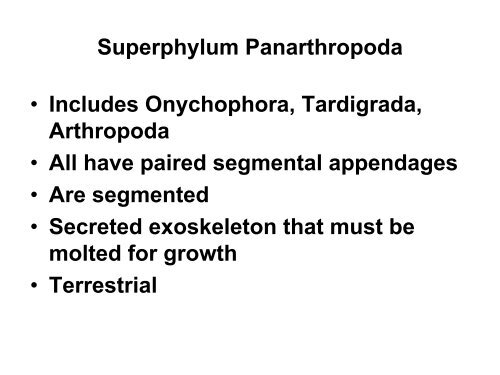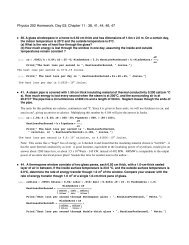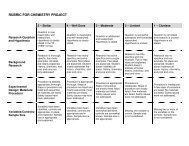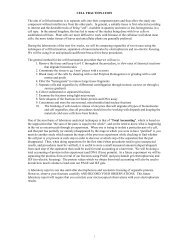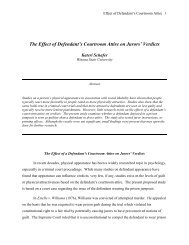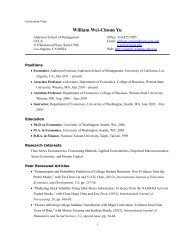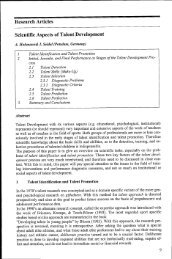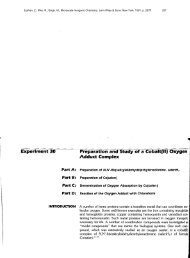Superphylum Panarthropoda
Superphylum Panarthropoda
Superphylum Panarthropoda
You also want an ePaper? Increase the reach of your titles
YUMPU automatically turns print PDFs into web optimized ePapers that Google loves.
<strong>Superphylum</strong><br />
<strong>Panarthropoda</strong><br />
• Includes Onychophora, Tardigrada,<br />
Arthropoda<br />
• All have paired segmental appendages<br />
• Are segmented<br />
• Secreted exoskeleton that must be<br />
molted for growth<br />
• Terrestrial
Phylum Onychophora<br />
• 110 described species<br />
• Tropics and temperate in Southern<br />
Hemisphere<br />
• Nocturnal<br />
• Need humid microenvironment
Phylum Onychophora<br />
• Wormlike (called velvet worms)<br />
• 5 –<br />
15 cm long<br />
• Segmented body –<br />
– Appendages<br />
– Ostia<br />
– Nephridia<br />
– Ganglia<br />
repetition of<br />
• Segmentation not actually visible
• Tagmosis<br />
• 13 -<br />
weak<br />
43 paired segmental trunk appendages<br />
– Similar, uniramous, fleshy<br />
– Called lobopods<br />
– Terminate with pair sclerotized<br />
claws
• Head appendages<br />
– Annulated, sensory antennae<br />
– Mandibles<br />
– Oral papillae<br />
– Slime glands – used to capture prey, can eject slime 15 cm<br />
from body
• Thin exoskeleton<br />
– Resembles arthropod – α-chitin, protein<br />
– Thin epicuticle and procuticle<br />
• Highly permeable (why habitat choice)<br />
• Molt frequently (every 2 wk over 6 yr<br />
life span
• Musculature<br />
• Hemal<br />
• Saccate<br />
• Trachea<br />
system<br />
nephridia
Onychophoran<br />
• Similarities with Annelids<br />
Phylogeny<br />
• Body-walled muscles in continuous<br />
sheets<br />
• Thin cuticle, lacking sclerotized plates<br />
• Weak tagmosis<br />
• Simple brain<br />
• Wormlike body
Onychophoran<br />
• Similarities with<br />
Arthropods<br />
• Ecdysis<br />
• Α-chitin and<br />
noncollagen protein<br />
• Coelom reduced to<br />
nephridia and gonads<br />
• Open hemal system<br />
• Appendages<br />
(mandibles) for feeding<br />
• Trachea<br />
• Superficial cleavage<br />
Phylogeny
Onychophoran<br />
• Similarities with Both<br />
• Segmented body<br />
Phylogeny<br />
• Paired segmental appendages<br />
• Paired segmental nephridia<br />
• Double ventral nerve with multiple<br />
ganglia
Onychophoran<br />
Phylogeny<br />
• May be an intermediate between<br />
annelids and arthropods<br />
• Other lines of evidence, including<br />
molecular, needed<br />
• If relationship not confirmed,<br />
similarities would be convergence
• Water bears<br />
• Most 0.3 – 0.5 mm,<br />
some reach 1.2 mm<br />
• ~600 species<br />
(always growing)<br />
• Aquatic – a few<br />
freshwater and<br />
marine; most in film<br />
• Cuticle<br />
Phylum Tardigrada
Tardigrade<br />
Mating
Tardigrada<br />
Phylogeny<br />
• Morphological similarities with<br />
Arthropoda and Cycloneuralia<br />
• Also molecular links between both<br />
groups<br />
• Why it is often grouped with “enigmatic<br />
phyla”


